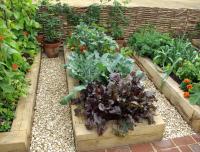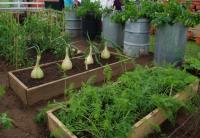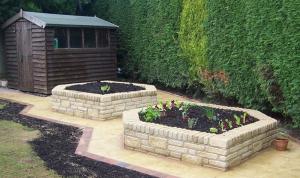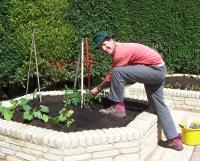Designing Raised Garden Beds
 Raised vegetable beds are an ideal way to grow your own produce
Raised vegetable beds are an ideal way to grow your own produceWhen thinking about the design of a raised garden bed there are a few key points that will require consideration during the design process.
Raised garden beds are very popular at the moment, but they are nothing new and have in fact been used by gardeners for centuries. Raised vegetable beds in particular offer many practical advantages to gardening and can help improve your yield of vegetables come harvest time. To find out more about the real and significant benefits of raised vegetable beds, read our article on "The Benefits of Raised Vegetable Beds".
Assuming that you are already sold on the benefits of a raised garden bed, or perhaps you just fancy one because you think it will look nice in your garden, then we will concentrate on the actual design factors that you should consider when designing your own raised beds for the rest of this article.
However, if the whole process of designing and building your own raised beds all seems too daunting, then you will be pleased to know that there are lots of commercially available ready made solutions for you to purchase off the shelf and install in your garden with the minimum of fuss. Click here to see some commercial raised bed options.
Material Choice
The first decision that you are going to have to make is as to your preferred choice of construction material. The two main options are either wood or brick/stone, although there is nothing stopping you from using a combination of both if you so wish.
Wood
 Wood is likeliest to be the cheaper option of the two, although its longevity will not be as good as building with brick or stone and after a few years may require some remedial maintenance. It is probably much quicker and easier to construct a raised bed from wood than from brick. The design possibilities for a wooden raised bed are quite vast ranging from the popular option of simply laying down a few strategically placed old planks of wood to a bespoke, carpentered solution with varying degrees of cost and complexity in between.
Wood is likeliest to be the cheaper option of the two, although its longevity will not be as good as building with brick or stone and after a few years may require some remedial maintenance. It is probably much quicker and easier to construct a raised bed from wood than from brick. The design possibilities for a wooden raised bed are quite vast ranging from the popular option of simply laying down a few strategically placed old planks of wood to a bespoke, carpentered solution with varying degrees of cost and complexity in between.
If wood is your material of choice, take care when selecting the particular timber. If you intend to grow edible produce in your wooden raised bed, avoid wood that has been preserved with toxic chemicals such as Creosote. If you choose to use toxically treated wood like old railway sleepers, you could consider lining the centre of the raised bed to prevent soil contact with the exposed surfaces of the wood.
Brick or Stone
A raised bed built of brick or stone will undoubtedly cost more than a wooden counterpart, potentially requiring the services of a professional bricklayer or builder to assist with its construction, it will also take significantly longer to construct. However, a professionally built stone or brick raised bed will not only last a lifetime and require no maintenance, but will make a grand architectural statement in your garden.
Cheaper options to brick or stone could include concrete blocks, or old paving stones, which you may be able to set into the earth without cement.
Design Considerations
Having decided upon the construction materials for your raised bed, the next thing to consider is its general size and positioning in your garden. During this process you might want to consider how many raised beds you are planning to have; one big one, or two or three smaller ones perhaps? Having more than one bed for growing edible produce can prove very beneficial by catering for crop rotation and the varying watering requirements of different plants.
Height
The height of a raised bed can be anything from a few inches off the ground to a few feet tall. The taller the bed, the better it will be for a number of reasons.
- Firstly you will be able to get a greater quantity of soil in, which may be much better than the surrounding soil, allowing the plants roots to go deep down into high quality soil. If you choose a taller bed however, remember that you are going to have to find the additional soil to fill it.
- Secondly, the deeper bed will warm up quicker than a shallower bed in the spring, bringing your crops forward faster.
- Thirdly, with a taller raised bed you won't have to bend over so far to tend to your plants, with the ultimate raised bed being waist high for this purpose.
Width
The primary factor determining the maximum width of a raised bed is how far you can practically lean over from the edge of the bed to reach its centre to tend to the plants. If you are taller than average, you may be able to tolerate wider beds than your shorter compatriots.
Location
To a greater or lesser degree, the location of the raised bed in your garden may affect its final size and shape, so it is a good idea to have a reasonable feel as to where your bed is going to be situated during the design process.
Locating your bed in a flat area of your garden can save you a lot of digging, whereas placing a few raised beds on a slope in a terrace fashion can help to utilise an otherwise difficult to work area of your garden. Avoiding shady areas is advised. Be sure to leave enough room between adjacent beds for comfortable access, with an increased width if you wish to get a lawnmower or wheelbarrow between them.
Flexibility and Iteration
During the planning stage, and indeed the construction stage, it is a good idea to be flexible as the plans are likely to evolve as different considerations come into play. Design and planning is a fluid, iterative process.
Design Inspiration
 Raised garden beds do not have to be plain old rectangular affairs all the same height and size. With a little thought and inspiration you can break with tradition and have something a little different to plant your vegetables in; your garden will thank you for it. Inspiration can occur from the strangest sources if you keep your mind open and receptive to ideas. Visiting other gardens and garden centres can be a useful source of inspiration as can surfing the web for ideas.
Raised garden beds do not have to be plain old rectangular affairs all the same height and size. With a little thought and inspiration you can break with tradition and have something a little different to plant your vegetables in; your garden will thank you for it. Inspiration can occur from the strangest sources if you keep your mind open and receptive to ideas. Visiting other gardens and garden centres can be a useful source of inspiration as can surfing the web for ideas.
Filed under Garden Design.


